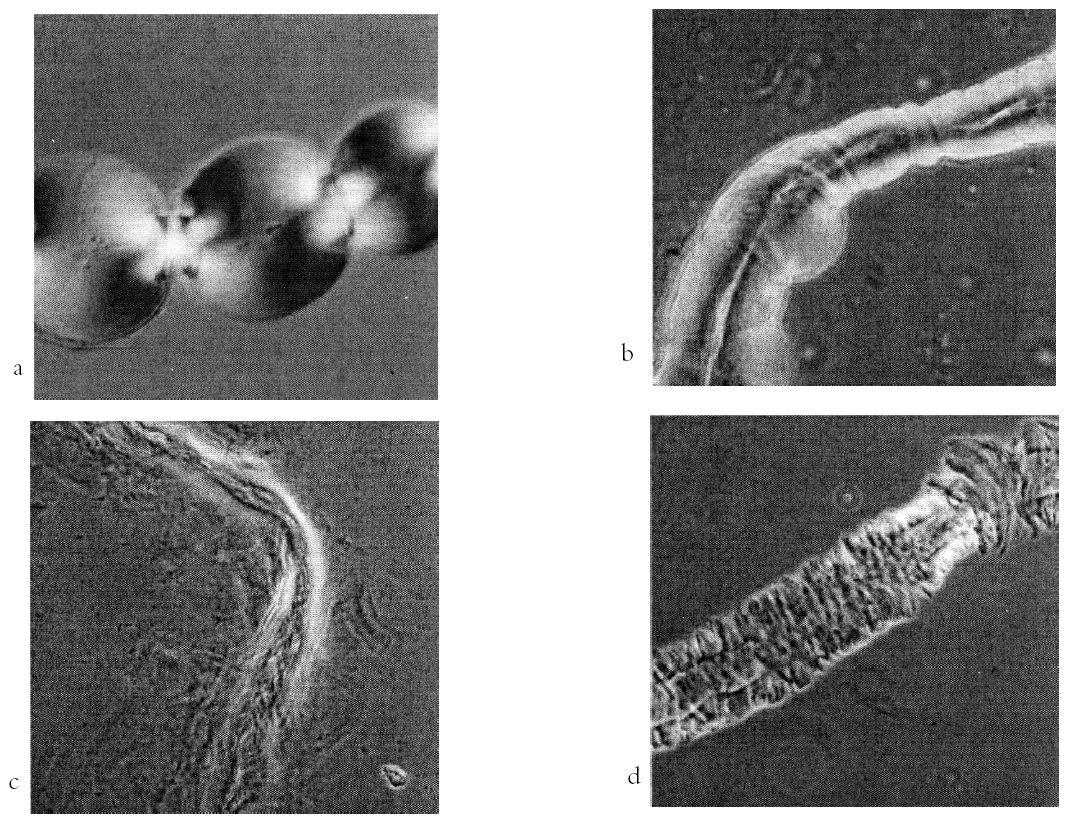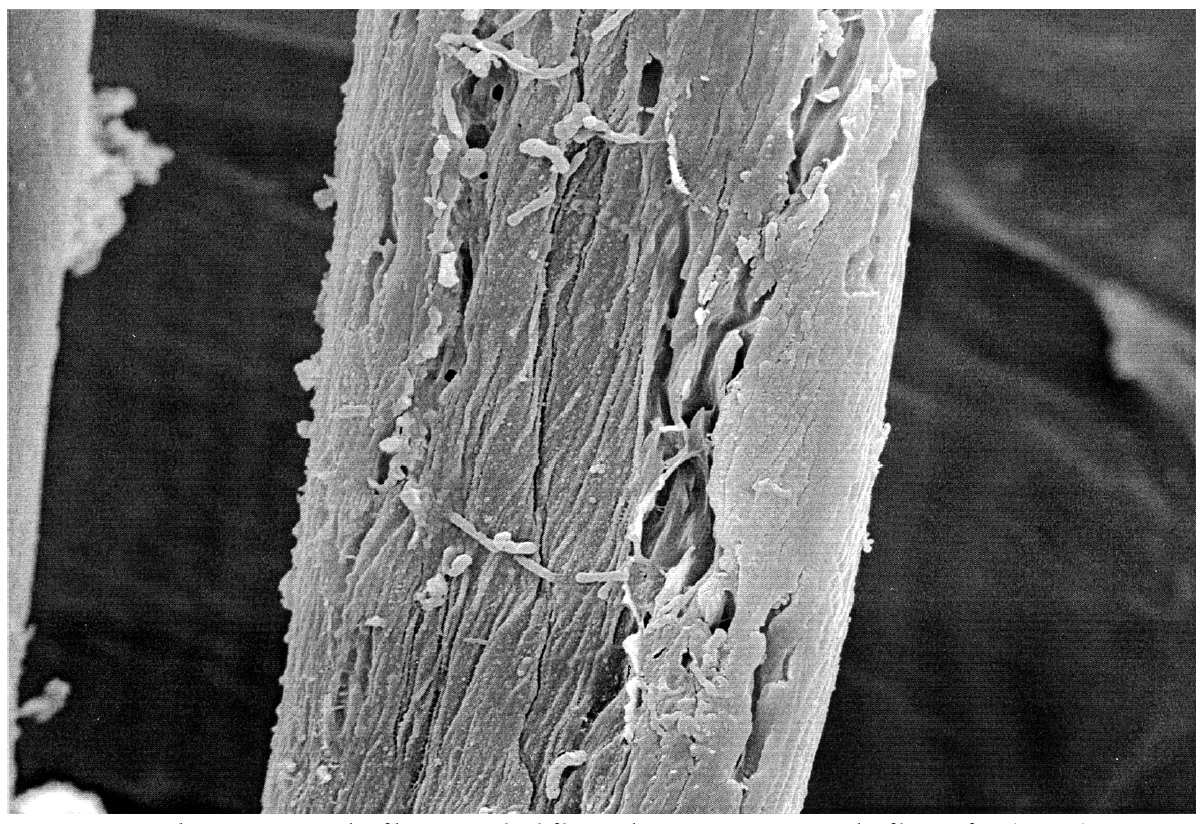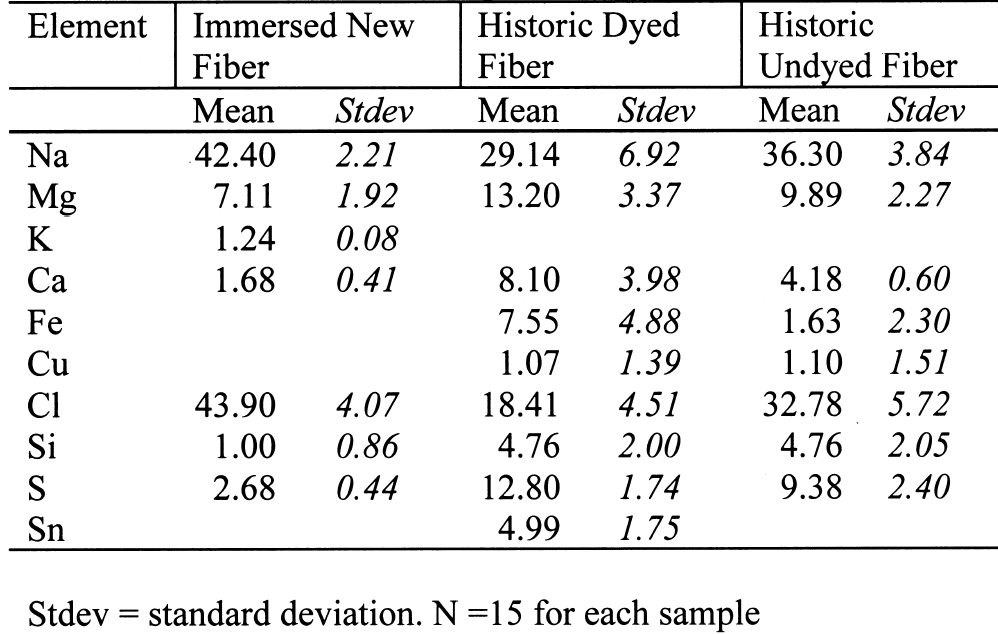CELLULOLYTIC BIODEGRADATION OF COTTON FIBERS FROM A DEEP-OCEAN ENVIRONMENTRUNYING CHEN, & KATHRYN A. JAKES
3 RESULTS AND DISCUSSION3.1 OPTICAL MICROSCOPYNo morphological differences between the specimens from the new and immersed new samples were observed prior to swelling treatment, with the exception of some small particulate deposits noted on the immersed fibers. Most of the historic dyed fibers displayed distinctly large fiber widths and a flat, convoluted, ribbon like appearance, characteristic of a coarse cotton species or of immature cotton fibers. Dark deposits were observed both on the surfaces of the fibers and inside the fibers' lumina, and some encrustation of the fiber surface was also seen. Overall, the historic dyed fibers displayed structures typical of cotton, with no obvious disruptions of morphology (figs. 1a, 1b). In contrast, morphological
After treatment with 18% sodium hydroxide, fibers from the new fabric sample appeared similar to typical mercerized cotton. They were smooth and rodlike without convolutions or lumina or with very small lumina. In comparison, the immersed new fibers contained a higher proportion of fibers with medium to small lumina. Particulate deposits were observed on some of the fibers as well, both on their surfaces and in their lumina. Treated with 18% NaOH (figs. 2a, 2b), the historic undyed fibers displayed more short fragments with more distinctive horizontal cracks in comparison to the fibers without treatment. The appearance of the historic undyed fibers suggests that they were severely biodegraded by micro-organisms. The degradation was localized, resulting in alternating fragments of intact and degraded fibers. The intact fragments are very similar in appearance to both the new and immersed new fibers after treatment with NaOH. The mean fiber width of the historic dyed cotton (23.6 �m) and the historic undyed cotton (20.3 �m) were found to be significantly larger than those of new cotton (16.2 �m) and the immersed new cotton (17.3 �m), as supported by Tukey's pairwise comparisons (a=0.05) (Toothaker 1993). Table 1 includes the confidence intervals for differences between group means provided by the Tukey analysis. The mean fiber widths of the historic dyed and historic undyed cottons were different, but those of both the new and the immersed new fibers was not significantly different from each other. The degree of fiber swelling, i.e., the % difference in fiber width before and after NaOH treatment, of both the new (58.9%) and the immersed new fibers (59.0%), was not significantly different (see table 1). The degree of swelling of specimens of the historic dyed sample (41.1%) was much smaller than that of the other three samples, whereas that of
Treatment with a mixture of NaOH and CS2 was intended to detect the nature of degradation that had occurred in the fibers since balloons will appear along treated cotton fibers with an intact primary wall. This phenomenon was observed on most of the new fibers but was not as predominant in the immersed new fibers (figs. 3a, 3b). Ballooning was not observed on the historic dyed and undyed fibers, indicating primary wall damage (figs. 3c, 3d). Longitudinal fibrillation was observed in fiber specimens from all four samples that had been immersed in the NaOH and CS2 mixture. Horizontal fragmentation or splitting, characterized by the development of narrow strips with tapered tips (see fig. 3d), was also observed. Only a few instances of this horizontal splitting were seen in the new and the immersed new fibers relative to the number observed in the historic dyed fibers and the historic undyed fibers. Fibers from the latter sample displayed the largest number of instances of this feature. One possible explanation for horizontal splitting is surface folding caused by a high degree of fiber swelling along the lateral direction, with shrinkage along the longitudinal direction. 3.2 SCANNING ELECTRON MICROSCOPYThe high resolution of the scanning electron microscope permitted fibers and particulate deposits on the scale of 50 nm to be examined (figs. 4a, 4b). Biodegradation, evident only in the historic undyed fibers, exposed the interior of the fiber secondary wall (figs. 5a, 5b). The size of the exposed interior area varied, and the exposed fiber interior structure indicated that the biodegradation process followed the fibril direction. Within the exposed fiber interior, multiple grooves about 250 to 500 nm in width could be seen (see fig. 5b). Micro-organisms had digested the cellulose in the region of contact, completely removing material in this 200 nm wide area. The grooves within the exposed fiber interior were clean with no particulate deposit. Figure 6 displays a fiber fragment on which two types of micro-organisms are observed. The rod-shaped micro-organisms are about 2 �m long and 200 nm wide, close to the dimensions of the grooves observed in exposed areas of the fiber interior. It appears that these rod-shaped micro-organisms have digested the cellulose molecules along the fibril direction, consistent with the characteristics of microbial degradation. Oval-shaped micro-organisms also were observed on the historic undyed sample. Next to them are holes in the fiber of the same dimension, apparent in figure 6, indicating penetration of the primary wall. It is possible that the rod-shaped micro-organism was a type of deep-ocean cellulolytic bacteria, while the oval-shaped micro-organism was a deep-ocean cellulolytic fungi due to the mode of cellulolytic attack (Siu 1951); however, it is not known whether the rod-shaped organisms are the same as the ones cultured from the trunk water samples (Herdendorf et al. 1995). The fact that the organisms grew on the textiles at the site indicates
3.3 ENERGY DISPERSIVE SPECTROSCOPY ANALYSISSodium and chlorine were the major elements present in the fibers of the three samples (table 2). The relative percentages of these, however, differ, with a combined total of about 86.3% in the immersed new sample; about 69.08% in the historic undyed sample, and 47.55% in the historic dyed sample. Because the percent composition that is
In both the historic dyed and undyed samples, the relative contents of sodium, magnesium, calcium, copper, chlorine, and silicon reflect the impact on the two fabrics of the accumulation of sediments and absorption of ions from the seawater. The small relative percentages of calcium and silicon in the immersed new sample compared to the two historic samples could reflect the short period of immersion and lack of accumulation of sediment. A smaller relative sulfur composition in the immersed samples may also reflect the lack of sufficient time or the appropriate conditions for sulfate reduction and sulfide deposition. It is likely that a longer period of time was required to produce the appropriate anoxic conditions for sulfate reduction. As both the historic dyed and undyed samples were from the same environment and the same item of clothing, their elemental compositions were found to be similar to each other, with the exception of iron, sulfur, and tin. Just as the black deposits on the surfaces of the marine textiles (Jakes and Wang 1993; Wang and Jakes 1994) contained iron and sulfur, the presence of iron and sulfur within the historic fibers examined in this study is indicative of sulfate reduction occurring in the system established in the trunk. The unique presence of tin in the historic dyed sample probably indicates that some form of tin was used as a mordant in dyeing. Dyeing recipes for a dark brown color used around the 1850s included use of tree bark extracts with tin and iron mordants (Crooks 1874). Because the percentage of iron detected in the historic dyed sample (7.55%) was so much higher than that detected in the historic undyed sample (1.63%), some of the iron present may be due to a mordant treatment rather than all of it coming from a deep-ocean source. According to Rouhi (1998), tin is toxic to bacteria and acts as a biocide agent in the marine environment. Therefore, it is highly possible that the tin contained in the dyed cotton fibers functioned as an inhibitor to the growth of marine micro-organisms and that the absence of the biocidal action of the tin in the undyed cotton fibers resulted in more severe biodegradation. 3.4 CONSERVATION IMPLICATIONSIn assessing a historic garment, the condition of Waterlogged textiles, whether from a marine site or some other wet site, will behave differently from materials that have never been stored wet. The long-term swollen state experienced by these materials might allow some molecular rearrangement even as microbial damage ensues. The textiles, returned to a terrestrial environment and dried, may still react in unexpected ways as they are treated. It is suggested that the observation of single fibers under the microscope while treating them in a planned protocol will allow the conservator to assess potential results. |




